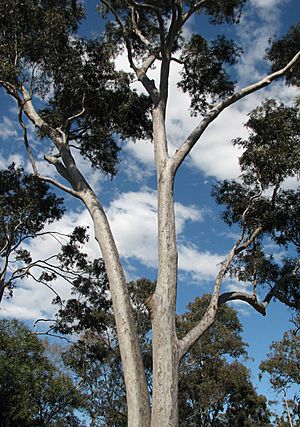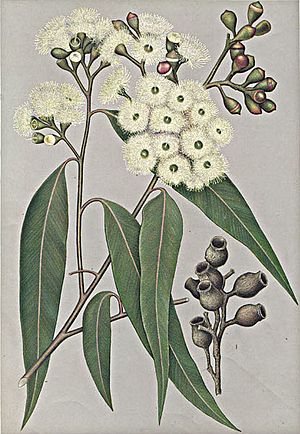Spotted gum facts for kids
Quick facts for kids Spotted gum |
|
|---|---|
 |
|
| Corymbia maculata (cultivated) in Burnley Gardens | |
| Scientific classification | |
| Genus: |
Corymbia
|
| Species: |
maculata
|
| Synonyms | |
|
|
The spotted gum (scientific name: Corymbia maculata) is a type of tree found only in eastern Australia. It is a medium to tall tree. You can easily spot it by its smooth, mottled bark. It has long, narrow leaves, white flowers, and fruit shaped like an urn or barrel.
Contents
What Does Spotted Gum Look Like?
Spotted gum trees can grow very tall, usually between 45 and 60 meters (about 150 to 200 feet) high. They have smooth bark that looks mottled, meaning it has different shades of pinkish-grey or bluish-grey. This bark peels off in small, uneven pieces.
Leaves and Flowers
Young spotted gum plants have shiny green leaves. These leaves are broadly egg-shaped or lance-shaped. They are about 7 to 19 centimeters (3 to 7.5 inches) long. Older trees have adult leaves that are the same green color on both sides. These leaves are lance-shaped or curved. They measure about 8 to 21 centimeters (3 to 8 inches) long.
The tree's flower buds usually grow in groups of three. Sometimes, there can be seven buds in a group. These buds are oval or pear-shaped. They are about 8 to 10 millimeters long. Spotted gum flowers are white. They bloom from March to September.
Fruit and Seeds
After flowering, the tree produces woody fruits. These fruits are shaped like an oval, a barrel, or a small urn. They are about 9 to 14 millimeters long. Inside these fruits are the seeds.
How is Spotted Gum Different from Similar Trees?
Two trees, Corymbia citriodora (lemon-scented gum) and C. henryi, look similar to spotted gum. However, they grow further north in Queensland. The adult leaves of the lemon-scented gum are a bit narrower than spotted gum leaves. C. henryi has wider leaves.
Spotted Gum's Name and History
The spotted gum was first officially described in 1844. A botanist named William Jackson Hooker gave it the name Eucalyptus maculata. Later, in 1995, two other botanists, Ken Hill and Lawrie Johnson, changed its name to Corymbia maculata.
The word maculata comes from Latin. It means "spotted." This name was chosen because of the spotted look of the tree's bark.
Where Does Spotted Gum Grow?
Spotted gum trees are common in open forests. They grow along the coast of New South Wales, from near Bega up to Taree. There is also a separate group of these trees near Orbost in Victoria. They often grow closely together in forests. They prefer soil that is not very rich in nutrients.
You can also find spotted gum trees growing in places where they are not native. This includes parts of Western Australia, South Australia, and some areas of New South Wales and Victoria.
Ecology: Who Likes Spotted Gum?
The white flowers of the spotted gum tree attract honeyeater birds. These birds feed on the nectar from the flowers.
Uses of Spotted Gum
Planting in Parks and Gardens
Spotted gum is often planted in parks and along streets. It makes a beautiful tree for these areas. However, because it grows so tall, it is usually not suitable for most home gardens.
Timber Uses
The wood from the spotted gum tree is very strong. People use it for many building projects. It is also used for flooring. The lighter colored wood (sapwood) can be attacked by a type of beetle called a Lyctus borer. To prevent this, the wood needs to be treated.
Images for kids



